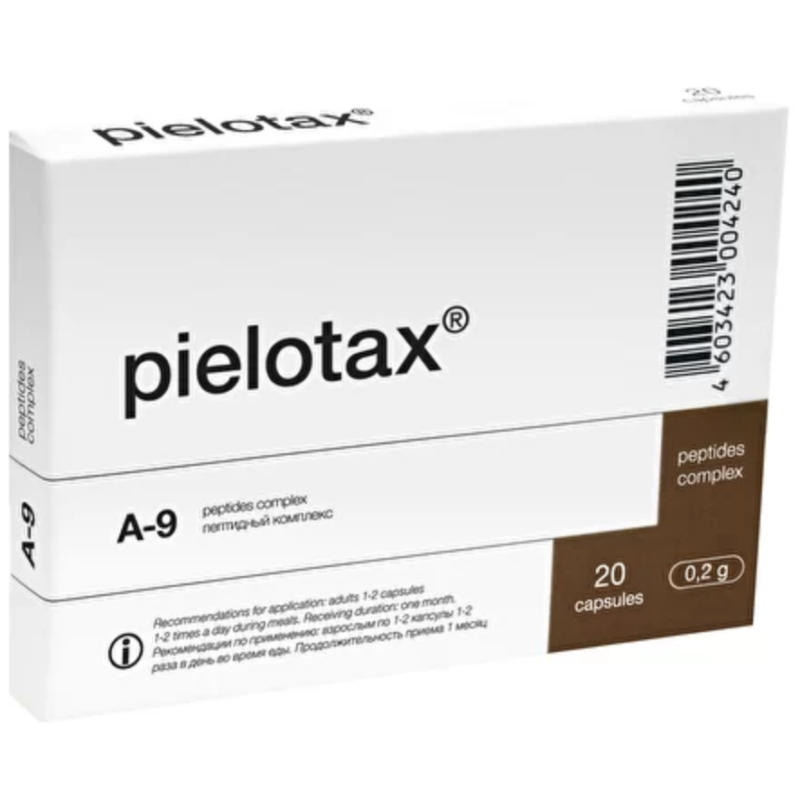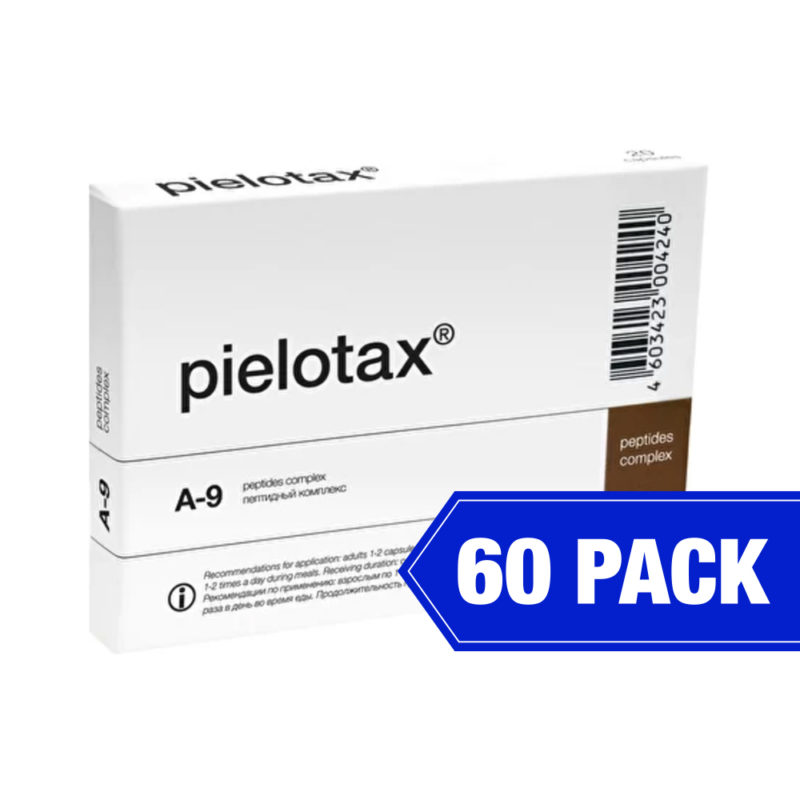REPORT on the results of clinical study of peptide bioregulator Pielotax
Pielotax®
A report of the results of clinical study of the biologically active peptide bioregulator of kidney origin:
The biologically active peptide bioregulator Pielotax contains a complex of low-molecular peptides with molecular weight up to 5000 Da, isolated from kidneys of young animals – calves aged up to 12 months.
Pielotax is manufactured in the form of capsules with a content of active substance of 10 mg.
Experimental studies have shown that the peptides possess tissue-specific action on the cells of the tissues from which they were isolated. Cerluten ® peptides regulate metabolism processes in the kidney tissue cells, increase urination system safety margins, having a favorable effect on the organism adaptation processes in extreme conditions, the possess anti-oxidative properties, regulating peroxide oxidation processes in the kidneys. So it is possible to extrapolate an efficiency of administration of Pielotax for restoration of the function of the kidneys and their disorders of various origins.
Metabolic disorders, essential hypertension, infectious and autoimmune disorders, especially age-related, frequently results in kidney affection (3).
Drug treatment of kidney diseases includes administration of the following drugs (1, 2):
· 4-aminoquinolinic series drugs (chloroquine, plaquenil)
· Iimmunomodulatory drugs (thymalinum, levamisole)
· Hypotensive drugs
· Vitamins C and E (antioxidants); etc.
Clinical study of Pielotax was carried out at the Medical center of the Saint Petersburg Institute of Bioregulation and Gerontology since February till August 2011.
Clinical study of Pielotax was carried out in patients with gouty nephropathy; distribution of the patients by sex and age is shown in the table 1. In total 42 patients have been taking part in the study. The patients with gouty nephropathy were complaining of periodic pain in the joints. In connection with long term morbidity in some patients the inflammatory changes were subclinical.
All the patients have been taking symptomatic and pathogenic therapy for the disease, which resulted in temporary reduction in intensity of the symptoms.
Using randomization method the patients were divided into 2 groups – control (15 people) and main (27 people). The patients of the control group have been taking general purpose medicines only.
The patients of the main group have been taking Pielotax, in addition to the general purpose medicines – per os 10-15 minutes before meal 1-2 capsules, 3 times a day before meal for 30 days depending on intensity of the pathological process.
Table 1
Distribution of the patients by diagnosis, sex and age
|
Diagnosis |
Age (years) |
Group |
Men |
Women
|
In total |
|
Gouty nephropathy |
43-67 |
control |
9 |
6 |
15 |
|
42-68 |
basic |
19 |
8 |
27 |
|
|
In total |
|
|
28 |
14 |
42 |
Examination methods
The patient complaints were assessed and compared, general clinical studies of blood and urine were carried out together with blood biochemical test using “REFLOTRON” device (Boehringer Mannheim, Germany). Ultrasonic examination was carried out using ultrasonic device (ALOKA, Japan).
Examination results
As a result of the studies performed it was established that administration of Pielotax lead to decrease in clinical signs of nephropathy in case of gout in 78% of cases. However, most significant were the results of laboratory tests. The drug administration resulted in activation of metabolism of kidney tissues and intensification of secretory kidney function, which is reflected in dynamics of biochemical indices of the patients (table 2).
According to the data shown in the table 2, the patients of the control group, treated using general purpose methods, had an improvement of biochemical blood indices, reflecting the kidney function. However these indices did not reach normal values. In patients of the basic group the biochemical parameters has reached normal values for men and women. Thus, non-protein nitrogen in the control group has made on the average before treatment 35,4±0,8 (mmol/l, and after treatment – 30,5±0,6 (mmol/l (p<0,05), however in patients o the basic group the parameter decreased to 27,1±0,4 (mmol/l, which is definitely lower in comparison to the control group and corresponds to lower normal limit (28,6 (mmol/l). Same tendency can be seen in the dynamics of the blood urea: decrease in the initially elevated parameter in patients of both groups, however in the basic group this parameter has made 9,2±0,3 (mmol/l, which is close to its normal value (8,3 (mmol/l).
There are also characteristic changes of uric acid content: both in men and women of the basic group after additional use of the drug under examination, the parameters were normalized – in men the amount of uric acid has decreased to 0,44±0,02 (mmol/l (in the control group 0,56±0,01 (mmol/l, norm up to 0,50 (mmol/l); in female of the basic group – up to 0,37±0,03 (mmol/l (in the control group 0,48±0,02 (mmol/l, norm up to 0,40 (mmol/l).
Table 2
Influence of Pielotax on biochemical blood parameters in patients with gouty nephropathy
|
Parameters |
Before treatment |
After treatment |
||
|
Control group |
Main group |
Control group |
Main group |
|
|
Nonprotein nitrogen, mmol/l |
35,4±0,8 |
34,1±0,7 |
30,5±0,6* |
27,1±0,4*# |
|
Urea, mmol/l |
14,7±0,5 |
13,8±0,6 |
11,8±0,5* |
9,2±0,3*# |
|
Uric acid, mmol/l Women Men |
0,57±0,01 0,75±0,03 |
0,55±0,02 0,78±0,04 |
0,48±0,02* 0,56±0,01* |
0,37±0,03*# 0,44±0,02*# |
* Р<0.05 in=”” comparison=”” with=”” the=”” parameter=”” same=”” group=”” of=”” patients=”” before=”” treatment=”” p=””>
#Р<0.05 in=”” comparison=”” with=”” similar=”” parameter=”” the=”” control=”” group=”” of=”” patients=”” p=””>
Thus the results obtain confirm treatment efficiency of Pielotax and expediency of its administration in complex treatment of patients with gouty nephropathy and other diseases related to kidney dysfunction.
Pielotax does not result in side effects, complications and drug dependence.
Pielotax can be used as medical and preventive mean in the form of biologically active food additive and in the form of adjunct in combination with any means of symptomatic and pathogenic therapy, used for treatment of patients with gouty nephropathy and other kidney diseases.
Conclusion
The biologically active peptide bioregulator Pielotax normalizes metabolism in kidney tissues.
Pielotax is well tolerated by patients at oral administration; it does not result in any side effects and can be widely used as a treatment and prophylactic biologically active food additive.
Pielotax is recommended to patients with gouty nephropathy and other diseases per os 10-15 minutes before meal 1-2 capsules 2-3 times a day for 15-30 days depending on severity of the pathological process.
It is recommended to carry out repeated treatment courses in 3-6 month.
It is expedient to recommend Pielotax for treatment and prophylaxis use.
References
1. Belousov Y.B., Moiseev V.S., Lepakhin V.K. Clinical pharmacology and pharmacotherapy: Manual for doctors. – M.: Universum, 1993. – 398 pages
2. Mashkovsky M.D. Medicines: Pharmacotherapy for doctors, manual: 2 parts. – Vilnius: ZAO “Gamta”, 1993.
Geriatry manual / Edited by D.F. Chebotarev, N.B. Mankovsky. – M.: Medicine, 1982. – 544 pages


